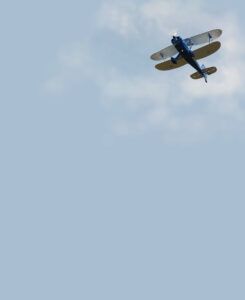
All apologies to John Gillespie Magee Jr. for the title to this column, but I did fly a little higher than normal on my last trip over the horizon.
First bit of business is to define high. What’s “high” in my box kite Starduster is just getting going to all the professional pilots who might be stopping by this column in search of a few smirks. Those jet jockeys get to see the little hand on the altimeter move all the time—that’s right, Maynard, there are three hands on round altimeters. The little one is just a thin line looking like a tie from 1982 and counts by 10,000s of feet. If you’re a crop duster down in the Delta, you’ve probably never noticed the thing; same for Midwest corn counters, Texas pig hunters, helo drivers (whether they wear helmets or not) and all my deviant friends who figure taller trees were put there to mark the turns.
For the rest of us, Mickey’s really thin third hand is admittedly an occasional thing. Even with all the hills around home, there’s not all that much call to get even a mile above the ground—and the ground is anywhere from literally sea level to 2000 feet. But if you’re leaving town, you’ll soon run into more serious rock piles, and as Starduster guru Dave Baxter enjoys pointing out, your aeroplane was designed to go over and not through them. So you end up climbing, and sometimes climbing some more.
So it was as I headed north to my annual hajj to the Reno pylons. Buzzing off the Pacific coastal plain was the usual postcard perfection: blue skies and viz pretty much to eternity. Although the big-block Starduster has no real bother climbing over the San Gabriel Mountains without cracking its wheel pants on the gravel, as usual lately I chickened out over that straight route. It takes over 7000 feet just to clear the rocks in the low places and there is nothing survivable below, just near-vertical canyon walls to boulder-strewn crags thousands of feet below. Peering over the cockpit coaming when just a few feet above such terrain makes me think about all the moving parts up front and my scarf goes limp. “Better to go around this,” says the old man in the back of my head. And it’s not that much out of the way, so I tell myself, to go a few miles east, putter up the relatively benign Cajon Pass and then chug a few miles west over the wide-open Antelope Valley before resuming the somewhat northerly heading to the Owens Valley.
Invariably the Antelope Valley—Mojave Desert—yields the sort of CAVU atmosphere expected of a place where they test jets and rockets and landed Space Shuttles, but this time the northern edge of the desert disappeared into a wall of brown gunk. There was a brown drape where the big mountains were supposed to start growing…and I started climbing. Experience said “fat chance,” but maybe I could climb over this stuff, which was smoke from a wildfire in the Sequoia National Forest. Hey, it’s California where even the smog is made from irreplaceable exotic organics and the state bird doesn’t fly. It jogs.
Whatever. Big trees, big fire and big smoke. Passing through 10,000 feet, I still wasn’t out of it. Laying my head back and looking over the top wing, there was gorgeous blue sky beckoning for what would effectively be VFR on top should I get above the stinking crud (it’s like flying in an ashtray). Looking down, the desert floor—which is about the same color as Sequoia smoke—appeared lazily in a tight, low-contrast circle. The smoke was getting thick enough that ground reference was technically still there, but I was beginning to wonder how long it would remain as I climbed. Ahead? Pure brown.
At 11,900 feet I gave up. The apparent top was false, like a hill that starts rounding off but keeps climbing when you’re on a bike and wishing it was a motorcycle. And it might have been nearly 100° F on the desert floor, but it was starting to chill down in my open cockpit, so I settled to 10,500 feet for hemispheric rule compliance, natch, and started looking for the mountains.
Eventually the Sierras appeared to port, but what a filtered, ghostly version of themselves. At this southern entrance to the Owens, the smoke was what was up and even the mountains—these are the real kind, with 14,500 feet of Mt. Whitney hiding somewhere up ahead—simply lurked. Normally omni-present as a granite wall, this time the mountains were somewhere at the bottom of a keyhole of sunlight, like the imagination running amok when staring down sunlit shafts into the profundity of the ocean and wondering what is just out of sight.
And that’s it really, imagination. Truth told, there was three miles of visibility, maybe more. But when there is nothing to see within three miles, the mind starts drawing dragons in the brown smoke. It was good to have that little portable GPS vibrating away on its RAM mount.
Before long the smoke let off to 20 miles of sepia tone, and I let down into Bishop for some low lead and Thai fried rice lunch. There was another leg to Reno but it turned out clear, and I didn’t bother going over 8000 feet.
Southbound
Eventually you have to turn around and go home, and even a week later the muck down south was still with us, if hardly as bad. But by then I was getting used to seeing the barber pole start to disappear on the altimeter and wanting to cheat the ever-present headwind by reducing the distance, I got to thinking about going straight home over those nasty San Gabriels. And so I climbed, and then climbed some more.
Going south into Pasadena the first hurdle is the mountains, followed by some Class B airspace terminating at 10,000 feet in the aptly named LA basin. That means 11,500 feet on my southeasterly heading and looking down at the airliners descending into LAX. I always hope someone looks up to see an open cockpit biplane above their Boeing, but they’re likely too busy to notice.
Eleven five is sort of up there when the mountains drop to the coast, and you can really only make out semis on the freeways. The disconnect from all that bother on the ground grows, and sometimes I tune in a tower just to confirm someone’s talking. But there are many benefits to flying above it all. It means a lot more gliding distance should the fan quit, and that’s no joke in the ’duster, which glides like a waxed bowling ball as I recently heard someone describe it. There’s less traffic above the Indian territories down low where tin Cherokees seemingly pop out of nowhere, although what big diesels are usually out and about really cover some sky. It’s good to develop an accelerated sense of just how fast an airplane gets from one side of the horizon to another or climbs up to greet you when dealing with the smokers. I pay a little more attention to keeping the biplane on altitude as well. It’s so easy to bobble up and down several hundred feet in an airplane that likes to loop and roll, but I’m sure that’s no comfort to anyone whose only interest is sorting me out as just another piece of traffic. Staying put is a good thing up high.
But mainly you can see so far, and those ferocious canyons mawing up at you aren’t so intimidating when the relative safety of semi-flat land—or two or three airports—is within your plunging bank vault engine-out radius. If it’s summer it’s also pleasantly cool aloft, and if it’s winter I sure hope you brought your woolies and leather. Year ’round is good for sunscreen on the ’ol schnoz as the UV aloft is brutal.
Of course there is less drag when above a meaningful percentage of the earth’s atmosphere, so wind willing, going higher might save gas and is often faster although you feel like you’re hanging from a pin in the ceiling as there is little perceptible motion with the ground. I’ll admit I have an advantage as my 10:1 compression ratio hangs in there longer than the limp handshake taking place in average general aviation combustion chambers. Plus, jet-setting in a biplane means you have plenty of drag to lose, so thinner air is a good thing for us wings-and-wires types. All said, I’m not giving up dusting off ocotillo bushes just yet, but I think I’ll be traversing more of that un-trespassed sanctity of space on the longer trips.

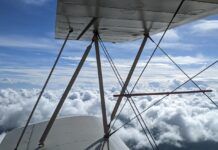
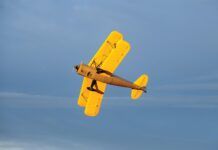
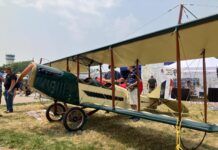
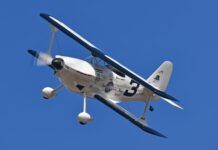
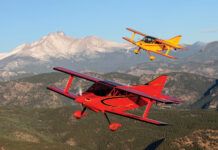
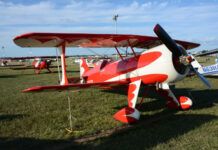
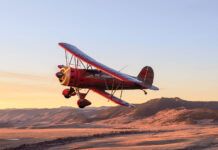

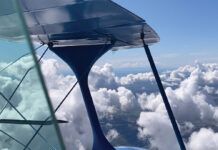
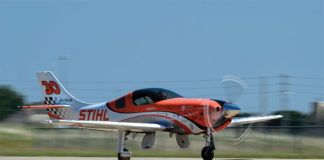


Excellent writing. Felt Like I was up there with him.
Look out for me in a Cherokee at those levels 🙂
Enjoyed your piece.
It was nice to read you story and very interested to read the flying in the USA
Much appreciated thank you
Sir